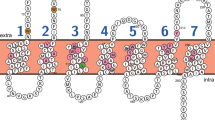Abstract
Non-diazotrophic cyanobacteria respond to nitrogen starvation by growth arrest and pigment degradation (chlorosis), resulting in dormant cells that are able to survive starvation periods for extended periods of time. Resuscitation from chlorosis by nutrient availability is a developmental process that is supported by a highly organized, genetically determined program.
Similar content being viewed by others
Literatur
Boresch K (1910) Zur Physiologie der Blaualgenfarbstoffe. Lotos 59:344–345
Allen M, Smith A (1969) Nitrogen chlorosis in blue-green algae. Arch Mikrobiol 69:114–120
Collier JL, Grossman AR (1994) A small polypeptide triggers complete degradation of light-harvesting phycobiliproteins in nutrient-deprived cyanobacteria. EMBO J 13:1039–1047
Karradt A, Sobanski J, Mattow J et al. (2008) NblA, a key protein of phycobilisome degradation, interacts with ClpC, a HSP100 chaperone partner of a cyanobacterial Clp protease. J Biol Chem 283:32394–32403
Forchhammer K, Schwarz R (2018) Nitrogen chlorosis in unicellular cyanobacteria – a developmental program for surviving nitrogen deprivation. Environ Microbiol, doi: 10.1111/1462-2920.14447
Kappell AD, Bhaya D, van Waasbergen LG (2006) Negative control of the high light-inducible hliA gene and implications for the activities of the NblS sensor kinase in the cyanobacterium Synechococcus elongatus strain PCC 7942. Arch Microbiol 186:403–413
Kato H, Kubo T, Hayashi M et al. (2011) Interactions between histidine kinase NblS and the response regulators RpaB and SrrA are involved in the bleaching process of the cyanobacterium Synechococcus elongatus PCC 7942. Plant Cell Physiol 52:2115–2122
Klotz A, Reinhold E, Doello S et al. (2015) Nitrogen starvation acclimation in Synechococcus elongatus: redox-control and the role of nitrate reduction as an electron sink. Life 5:888–904
Gorl M, Sauer J, Baier T et al. (1998) Nitrogen-starvationinduced chlorosis in Synechococcus PCC 7942: adaptation to long-term survival. Microbiology 144:2449–2458
Sauer J, Schreiber U, Schmid R et al. (2001) Nitrogen starvation-induced chlorosis in Synechococcus PCC 7942. Low-level photosynthesis as a mechanism of long-term survival. Plant Physiol 126:233–243
Klotz A, Georg J, Bucinska L et al. (2016) Awakening of a dormant cyanobacterium from nitrogen chlorosis reveals a genetically determined program. Curr Biol 26:2862–2872
Doello S, Klotz A, Makowka A et al. (2018) A specific glycogen mobilization strategy enables rapid awakening of dormant cyanobacteria from chlorosis. Plant Physiol 177:594–603
Watzer B, Forchhammer K (2018) Cyanophycin synthesis optimizes nitrogen utilization in the unicellular cyanobacterium Synechocystis sp. PCC 6803. Appl Environ Microbiol, doi: 10.1128/AEM.01298-18
Spat P, Klotz A, Rexroth S et al. (2018) Chlorosis as a developmental program in cyanobacteria: the proteomic fundament for survival and awakening. Mol Cell Proteomics 17:1650–1669
Author information
Authors and Affiliations
Corresponding author
Additional information
Karl Forchhammer 1979–1986 Chemie- und Biologiestudium an der LMU München. 1992–1993 Postdoc-Aufenthalt am Institut Pasteur, Paris, Frankreich. 1996 Habilitation an der LMU München. 1999 Professur an der Universität Gießen. Seit 2007 Leitung des Lehrstuhls für Mikrobiologie/Organismische Interaktionen an der Universität Tübingen.
Rights and permissions
About this article
Cite this article
Forchhammer, K. Erwachen aus der Chlorose: Wie scheintote Cyanobakterien ergrünen. Biospektrum 25, 132–135 (2019). https://doi.org/10.1007/s12268-019-1019-9
Published:
Issue Date:
DOI: https://doi.org/10.1007/s12268-019-1019-9




